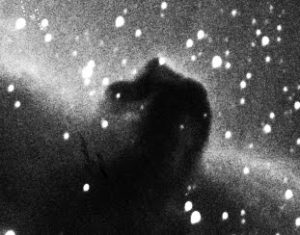I wondered how today’s CCD cameras compare with the old film cameras. So just for the fun of it I found a picture of the Horsehead Nebula that was taken on film by the 200″ aperture Palomar Telescope (at the time the image was taken it was the largest scope in the world!) and compared it to the scope at TRO with an 8″ aperture and digital camera. As you can see in the images below, the film image is much less grainy and more details can be seen. However, the TRO image shows up well for an instrument that is 192″ smaller and just an amateur scope.


What this really demonstrates is how much more efficient the digital cameras are at recording light. The ST-7E at TRO records around 82% of the light and film records around 10% (unless it is chemically enhanced to get 15%-20%). So an 8″ scope with a CCD actually performs like a much larger one versus the same setup with film. This is why small amateur telescopes are taking images every night that rival professional level efforts in the pre-digital age.